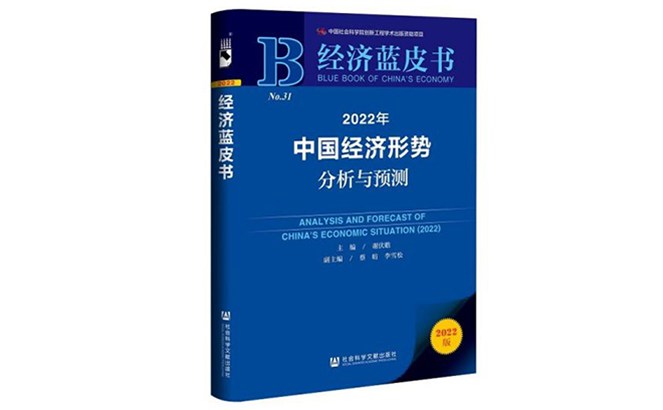
. > WHAT'S NEW > REPORTS
Blue Book of China’s Economy released
Author : GAO YING Source : Chinese Social Sciences Today 2021-12-17

FILE PHOTO: The cover of the Blue Book
On December 6, the Chinese Academy of Social Sciences (CASS) held a press conference to release the Blue Book of China’s Economy (2022) in Beijing, focusing on analysis and forecast of China’s economic situation.
According to the Blue Book, the global economy will continue its recovery trend, but the recovery is facing uncertainty. China’s economy is expected to grow by 8% in 2021, with an average growth rate of 5.1% between 2020 and 2021. Considering the ongoing global pandemic, China’s economy is expected to see a growth rate of about 5.3% in 2022, and an average growth rate of 5.2% from 2020 to 2022.
In the first three quarters, China’s economy displayed a strong recovery trend, with achievements in high-quality economic development, structural transformation, and upgrading. This has laid a solid foundation to achieve the economic development targets of the 14th Five-Year Plan (2021–25), said CASS President Xie Fuzhan.
“At the same time, we should also be soberly aware that our country is still facing some problems and challenges in the current economic operation, which require further research and a proper response,” Xie said.
Going forward, Xie made the following suggestions for China’s economic growth. First, scientific and precise prevention and control of the pandemic is important to effectively responding to the pandemic’s fallout. The COVID-19 pandemic is still the biggest uncertain factor for economic recovery at present and in the future. In addition, it is necessary to effectively deal with the decentralization, diversification, regionalization, and localization of global industries, while alleviating the impact on the supply chain of the industrial chain brought about by chip shortages, increasing prices of bulk commodities, and tight international shipping capacities.
Second, it is vital to coordinate the advancement of supply-side structural reforms and effective demand management. There are both supply-side and demand-side problems in the country’s economic operation. In the short term, insufficient effective demand has a more prominent impact on the economy, Xie said. Xie suggested appropriately strengthening counter-cyclical adjustments of macroeconomic policies and preventing contraction of effective demand through comprehensive measures, thus creating more space for supply-side structural reforms.
Xie also discussed green growth. It is necessary to accelerate research to help formulate the “N” in the “1+N” policy framework for carbon peaking and carbon neutrality, facilitating better-informed decision-making for each region and industry. At the same time, it is important to accelerate the establishment of a statistical monitoring and standard system for carbon emissions, while also improving supporting financial, fiscal, and taxation policies. As such, the green and low-carbon transformation will be facilitated in a gradual, steady, and orderly manner.
Former CASS Vice President Cai Fang said that quality employment shapes the quality of people’s livelihoods and the quality of development. At present, structural problems have replaced problems with total employment as the main contradiction in national employment. Structural unemployment is caused by a mismatch between workers’ skills and employer demands. Technological transformations and industrial upgrading have eliminated old jobs and created new jobs. The market has a huge demand for human capital with new skills, but improvement of labor quality has been relatively slow, which has led to an increase in the natural rate of unemployment.
From a domestic perspective, with a slowdown in growth of the average number of years of education for the Chinese population, and the negative growth of the newly-growing labor force, the total scale of new human capital tends to shrink, and it is more difficult for the average years of education per capita to continue increasing, Cai noted. An international comparison can reveal that there is still a large gap between the average years of education among adults in China and their counterparts in developed countries. As such, intensifying efforts to improve the education levels and extend the number of years of education are important as China copes with these contradictions in employment at present and in the future.
The 14th Five-Year Plan period will witness the accelerated development of the digital economy in China, said Jiang Xiaojuan, dean of the School of Public Policy and Management at Tsinghua University. The 14th Five-Year Plan proposed increasing the added value of core industries of the digital economy to 10% of GDP by 2025, which is a significant increase from the 13th Five-Year Plan period.
“This is a goal that requires hard work. In the context of digital technology creating new growth space and digital globalization bringing new opportunities, we should remain confident in achieving this goal,” Jiang noted.
China is leading the world in the number of 5G base stations and users, and the scale of digital investment is huge, Jiang continued. Various forms of industrial internet are extensively and deeply linked to form a new industrial ecology, and digital production is rapidly expanding. At the same time, the massive data quantities formed by digital technology links and the huge number of cross-border users without additional costs have made digital globalization a necessary choice, resulting in global technological and industrial optimization and reorganization which have improved overall production efficiency.
Ye Shengtao made Chinese fairy tales from a wilderness
Ye Shengtao (1894–1988) created the first collection of fairy tales in the history of Chinese children’s literature...
-
How northern ethnicities integrated into Chinese nation
2023-09-18
-
Mogao caves
2023-09-12
-
Mogao Grottoes as ‘a place of pilgrimage’
2023-09-12
-
Time-honored architectural traditions in China
2023-08-29
-
Disentangling the civilizational evolution of China
2023-08-28
-
AI ethics in science fiction
2023-08-23













 2011-2013 by www.cssn.cn. All Rights Reserved
2011-2013 by www.cssn.cn. All Rights Reserved